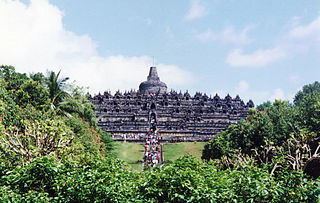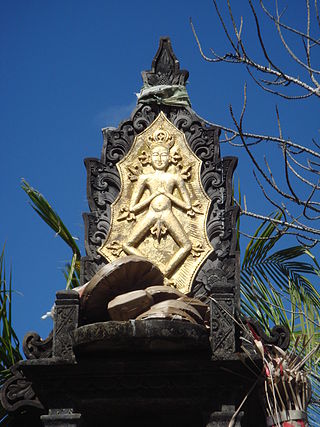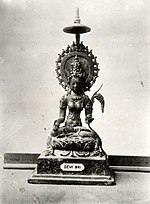
Yama or Yamarāja (यमराज), is a deity of death, dharma, the south direction, and the underworld who predominantly features in Hindu and Buddhist religion, belonging to an early stratum of Rigvedic Hindu deities. In Sanskrit, his name can be interpreted to mean "twin". He is also an important deity worshipped by the Kalasha and formerly by the Nuristani peoples, indicating his prominence in ancient Hinduism.

Lakshmi, also known as Shri, is one of the principal goddesses in Hinduism. She is the goddess of wealth, fortune, power, beauty, fertility and prosperity, and associated with Maya ("Illusion"). Along with Parvati and Saraswati, she forms the Tridevi of Hindu goddesses.

Hinduism in Southeast Asia had a profound impact on the region's cultural development and its history. As the Indic scripts were introduced from India, people of Southeast Asia entered the historical period by producing their earliest inscriptions around the 1st to 5th century CE. Today, Hindus in Southeast Asia are mainly Overseas Indians and Balinese. There are also Javanese and Balamon Cham minority in Cambodia and south central Vietnam who also practice Hinduism.

Balinese Hinduism is the form of Hinduism practised by the majority of the population of Bali. This is particularly associated with the Balinese people residing on the island, and represents a distinct form of Hindu worship incorporating local animism, ancestor worship or Pitru Paksha, and reverence for Buddhist saints or Bodhisattava.

The culture of Indonesia has been shaped by long interaction between original indigenous customs and multiple foreign influences. Indonesia is centrally-located along ancient trading routes between the Far East, South Asia and the Middle East, resulting in many cultural practices being strongly influenced by a multitude of religions, including Buddhism, Christianity, Confucianism, Hinduism, and Islam, all strong in the major trading cities. The result is a complex cultural mixture, often different from the original indigenous cultures.

Hinduism has historically been a major religious and cultural influence in Java, Indonesia. Hinduism was the dominant religion in the region before the arrival of Islam. In recent years, it has also been enjoying something of a resurgence, particularly in the eastern part of the island.

The Balinese people are an Austronesian ethnic group native to the Indonesian island of Bali. The Balinese population of 4.2 million live mostly on the island of Bali, making up 89% of the island's population. There are also significant populations on the island of Lombok and in the easternmost regions of Java.

The Nagas are a divine, or semi-divine, race of half-human, half-serpent beings that reside in the netherworld (Patala), and can occasionally take human or part-human form, or are so depicted in art. A female naga is called a Nagi, or a Nagini. According to legend, they are the children of the sage Kashyapa and Kadru. Rituals devoted to these supernatural beings have been taking place throughout South Asia for at least 2,000 years. They are principally depicted in three forms: as entirely human with snakes on the heads and necks, as common serpents, or as half-human, half-snake beings in Hinduism, Buddhism, and Jainism.

Hinduism in Indonesia, as of the 2018 census, is practised by about 1.74% of the total population, and almost 87% of the population in Bali. Hinduism was the dominant religion in the country before the arrival of Islam and is one of the six official religions of Indonesia today. Hinduism came to Indonesia in the 1st-century through Indian traders, sailors, scholars and priests. A syncretic fusion of pre-existing Javanese folk religion, culture and Hindu ideas, that from the 6th-century also synthesized Buddhist ideas as well, evolved as the Indonesian version of Hinduism. These ideas continued to develop during the Srivijaya and Majapahit empires. About 1400 CE, these kingdoms were introduced to Islam from coast-based Muslim traders, and thereafter Hinduism, which was previously the dominant religion in the region, mostly vanished from many of the islands of Indonesia.

Kejawèn or Javanism, also called Kebatinan, Agama Jawa, and Kepercayaan, is a Javanese religious tradition, consisting of an amalgam of animistic, Buddhist, and Hindu aspects. It is rooted in Javanese history and religiosity, syncretizing aspects of different religions.

Nyi Roro Kidul is a supernatural being in Indonesian folklore. She is the Queen of the Southern Sea in Sundanese and Javanese mythology.

Several different religions are practised in Indonesia. Indonesia is officially a presidential republic and a unitary state without an established state religion. Indonesia has the world's largest Muslim population and the first principle of Indonesia's philosophical foundation, Pancasila, requires its citizens to state the belief in "the one and almighty God". Although, as explained by the Constitutional Court, this first sila of Pancasila is an explicit recognition of divine substances and meant as a principle on how to live together in a religiously diverse society; it isn't an endorsement of a particular theological doctrine on how religions or beliefs should be practised. However, blasphemy is a punishable offence and the Indonesian government has a discriminatory attitude towards its numerous tribal religions, atheist and agnostic citizens. In addition, the Aceh province officially enforces Sharia law and is notorious for its discriminatory practices towards religious and sexual minorities. There are also pro-Sharia and fundamentalist movements in several parts of the country with overwhelming Muslim majorities.

Brem is traditional fermented food or fermented beverage from Indonesia. There are two types of brem, brem cake (solid) that is usually eaten as snack from Madiun and Wonogiri, and brem beverage (liquid) made of rice wine from Bali and Nusa Tenggara, but mostly known from Bali. Brem first appeared in Java around the year 1000, based on investigations regarding old Javanese inscriptions and literature.

Achintya, also known as Sang Hyang Widhi Wasa and Sang Hyang Tunggal, is the Supreme God of Indonesian Hinduism, especially on the island of Bali. Achintya is equivalent to the metaphysical concept of Brahman of Indian Hinduism, and is the Supreme God in traditional wayang theatre. All gods, goddesses and existence are believed to be the manifestation of the Achintya in Balinese Hinduism.

Dewi Sri or Shridevi is the Javanese, Sundanese, and Balinese Hindu Goddess of rice and fertility, still widely worshiped on the islands of Java, Bali and Lombok, Indonesia. She is often associated or equated with the Hindu goddess Lakshmi, the shakti (consort) of Vishnu.

The mythology of Indonesia is very diverse, the Indonesian people consisting of hundreds of ethnic groups, each with their own myths and legends that explain the origin of their people, the tales of their ancestors and the demons or deities in their belief systems. The tendency to syncretize by overlying older traditions with newer foreign ideas has occurred. For example, the older ancestral mythology might be merged with foreign mythology, such as Hindu, Islam, or Christian biblical mythology.

Wawacan Sulanjana is a Sundanese manuscript containing Sundanese myths. The title means "The Tale of Sulanjana", derived from the name of the hero Sulanjana as the protector of rice plant against the attack of Sapi Gumarang cow, Kalabuat and Budug Basu boars symbolizing rice pestilence. The Wawacan Sulanjana contains Sundanese local wisdom through reverence of rice cultivation in its tradition.

Batara Guru is the name of a supreme god in Indonesian Hinduism. His name is derived from Sanskrit Bhattaraka which means “noble lord". He has been conceptualized in Southeast Asia as a kind spiritual teacher, the first of all Gurus in Indonesian Hindu texts, mirroring the guru Dakshinamurti aspect of Hindu god Shiva in the Indian subcontinent. However, Batara Guru has more aspects than the Indian Shiva, as the Indonesian Hindus blended their spirits and heroes with him. Batara Guru's wife in Southeast Asia is Shiva's consort Durga.

Ananta, is a Sanskrit term, and primarily an epithet of Vishnu.



















